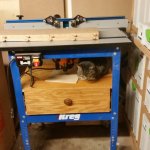Patrick Cox
Member
- Joined
- Apr 25, 2016
- Messages
- 173
Edward A Reno III said:Good question. I use my Festool routers just as much as my Domino, so it would be a difficult choice. One part of me says the Domino, since there is really nothing else like it on the market. There are some cost effective dowelers starting to come to the market in the US, like the Triton, but never having used one, I can't say how it compares to the Domino:
http://bistritontools.com/tdj600-tr...E4WZ0b4GibABLmiRPpeyGBA3J6LzKFvJB4aAoC38P8HAQ
For the router, there are just as good if not better brands for building out your routing capabilities. You will definitely want a router table at some point, in which case you would go for a heavy duty model like a PC 3.5HP motor, or, what is my choice given its above the table adjustment capabilities, the Triton 3.25HP TRA001. The OF2200 is an amazing router, but it only works as a table router in the CMS (unless you want to get into building your lift mechanism, which I assume you do not), and in the United States, one is not allowed to actually use it in the table (not that you can't, but should something go wrong you've voided the warranty by doing so, plus, the CMS is priced at what they charge for a kidney in Iran these days).
You will want a decent powered hand-held router as well, but you may be able to get by for the moment with a relatively inexpensive trim or compact router. You will just have to live with crappy dust collection.
Thanks for your reply. One thing that is at the top of my list is Dust extraction. This is because I have allergies and would like to keep dust to a minimum. So any selections I make will have that in mind.
In terms of router tables, when are the times when one would prefer using a router mounted to a table vs hand held?
Thanks

